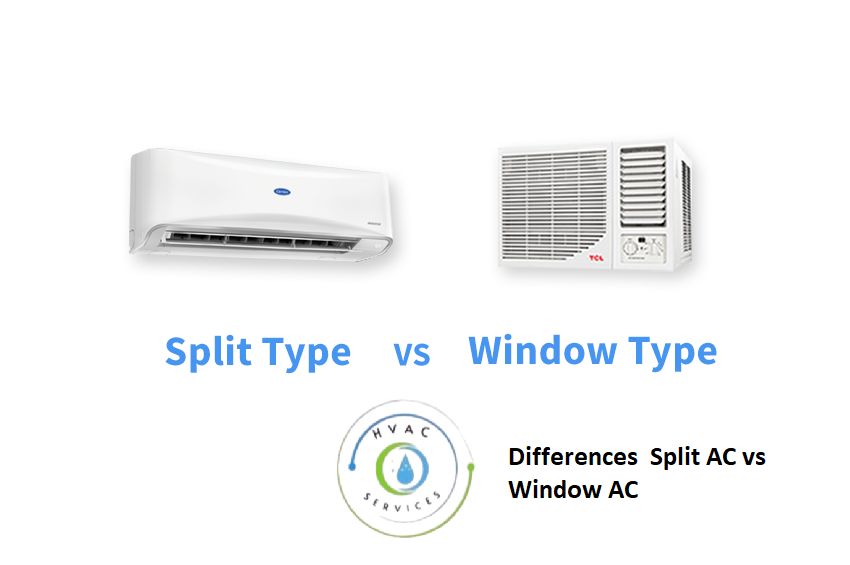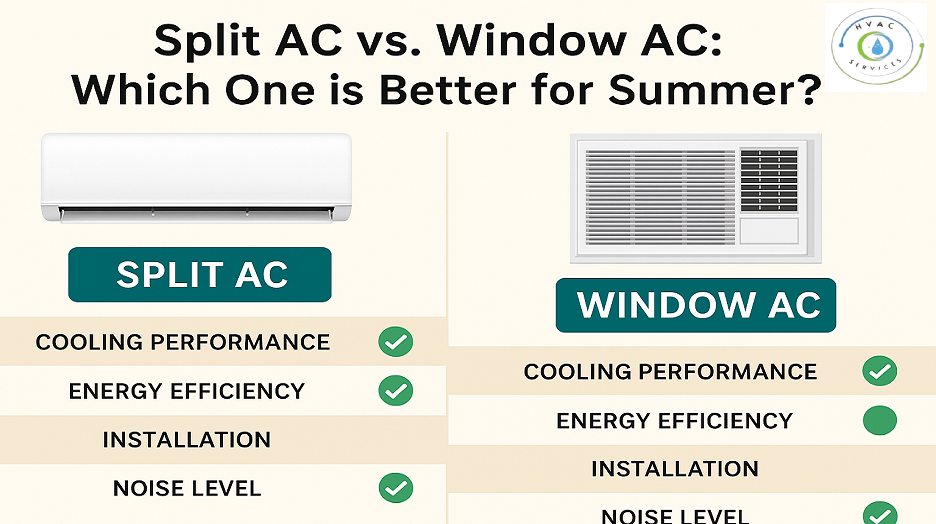Understanding the Basics of Air Conditioners
When I come home after a long day of work at the office, the heat outside makes me crave some coolness. Sitting on the sofa, I can feel the air-conditioning bring a refreshing breeze that wakes up my senses and removes the tiredness. On a rainy afternoon or a hot evening, that gentle cool atmosphere adds comfort and helps me regain vitality instead of sinking into laziness.
From my visits to the market, I’ve seen how brands highlight advantages, characteristics, and operational details of their models. Some focus on quality, others on price, and every seller claims their ACs are best. But the real choice comes down to what fits your space, whether you value style, performance, or practicality. Knowing the difference between a Split AC vs Window AC helps you continue enjoying the right balance of cool and comfort for your lifestyle.
What is a Split AC
When I first installed a Split AC in my room, I was amazed at how its parts were cleverly separated. One unit stays inside, fixed on the wall or even near the ceiling, while the other is kept outside. These two devices are joined with wires and pipes that connect the compressor and the mechanical refrigeration system. Unlike a window AC, there is no need to cut a big hole that matches the dimensions of the machine. This makes it more flexible and often better for the air conditioning setup of modern homes.
What impressed me most was the elegant design that adds beauty to the decor of the space while keeping the atmosphere fresh. These ACs use advanced technologies to facilitate efficient cooling for large areas, while being less energy consuming. The low sound ensures calmness without any disturbance, making it more suitable for bedrooms or offices. With regular maintenance and cleanliness, a Split AC remains durable and long-lasting, proving to be a wise choice over a basic window unit.

What is a Window AC
A Window AC is a compact type of air conditioner designed as a single unit that can be installed directly into a window or wall opening. From my own experience, these ACs are quite easy to install, and the components come together in one box, which makes them simple to maintain. They are suitable for rooms, offices, or any small area, and they can even handle medium spaces depending on how much cooling you need. Unlike a split AC, which requires more space and setup, a window model is often the first choice for people who want quick installation and reliable performance.
Another thing I’ve noticed is that periodic cleaning and maintenance help avoid faults and keep the AC running for a long time. You may need to wash the filters and sometimes fill or check the Freon gas inside to keep the performance stable. For those who move often, the AC is also easier to transport and place in a new location. It covers basic cooling needs at a relatively lower cost, which is an important factor for many households.

Key Differences Between Split AC vs Window AC
Read More Here: Top AC Energy Saving Tips
A proper comparison of these cooling systems makes things easier. Split ACs are usually quieter and look modern, while window ACs are compact and easier to install. Over the years, Split AC vs Window AC have tested both, and I noticed that a split AC works better for larger rooms, while a window AC suits smaller spaces.
Still, the final call depends on comfort, budget, and room type. For someone who values design and silent cooling, a split unit might feel like the right pick. But if quick setup and lower cost matter more, then a window unit can be the smarter AC option.

-
Design and Structure
When it comes to design, I’ve always noticed how a split AC adds a touch of elegance to modern spaces. It blends in with different colors of walls and furniture, and the distinguished look really gives an advantage in rooms where style dictates the overall setup. On the other hand, a window AC has a more simple look, but it still requires less effort in the installation process, which I’ve found much easier to use in smaller rooms both are Split AC vs Window AC.
From my experience, a split AC often requires extra transportation, careful dismantling, and even recharging in every service, which can feel like handling with your own hand step by step. A window AC, compared in its way, is specific to a single unit and doesn’t need the same level of effort. Each option, in its other form, gives benefits depending on how you plan to manage and maintain it.
-
Installation Requirements
From my own experience setting up Split AC vs Window AC are cooling systems, I’ve noticed that Split ACs are often the ideal choice for large rooms or spaces. They work well even in areas without windows, since they don’t rely on a traditional opening to operate. I once installed a unit in a living room that had no proper window, and it blended perfectly while keeping the entire place cool.
On the other hand, Window ACs are designed to fit directly into windows, which makes them practical if your room has the right kind of opening. But this limits where you can place them, and in modern apartments with fewer or smaller windows, this can be tricky. Personally, I find them better for compact rooms, but less practical for large spaces where flexibility is important.
-
Noise Levels
From my own use, I noticed that Split AC vs Window AC the compressor in a Split AC is kept enclosed outside the house, so the noise indoors feels less amplified, and the cool air output is smooth, while with a Window AC all the components are fitted indoors, which often makes the running sound more noticeable.
Benefits of Split AC
-
Stylish and Modern Look
From my own setup at home, Split AC vs Window AC I noticed that split air conditioners easily blend with modern living environments because the sleek indoor unit is less visible when placed neatly inside the apartment, making the room look more stylish without breaking the flow of décor.
-
Quiet Functioning
From my own experience, split systems are better when it comes to quiet performance because the compressor is fixed in the outdoor unit, which makes the installation design smart and keeps the inside calm; this setup can really provide a peaceful environment in bedrooms or even works paces, unlike a noisy window unit that often disturbs the mood.
-
Better Energy Efficiency
From my own experience, split ACs with inverter technology deliver steady cooling and smoother performance, which often leads to reduced electricity bills and long-term cost benefits; by choosing this setup, the energy use turns smarter, the savings feel more noticeable, and the improved system you adopt gives real results in comfort and efficiency.
-
Flexible Placement Options
From my own setup, I’ve found Split ACs to be ideal for rooms that are large or built without proper windows, since they do not rely on the traditional design where window ACs must fit into a fixed wall slot; this makes them a smart choice for open spaces where bulky units may not work well.
Limitations of Split AC
-
Expensive Installation
From my own experience, I noticed that a Split AC usually feels more professional in setup because special installation is required and that often will increase the costs, especially when technicians need to add extra pipes and wiring that are directly related to the unit, so it is often a bit more complex compared to a Window AC, which usually doesn’t demand the same level of work.
-
Requires Outdoor Unit Space
From my own experience, installing a Split AC always comes with the challenge of finding the right option for placing the condenser unit in suitable outside locations, and while it feels easier when you have an accessible spot like a balcony or open wall, it can be tricky in apartments where such spaces are limited compared to a Window AC.
Benefits of Window AC
-
Budget-Friendly Choice
From my own experience, a window AC is often the most wallet-friendly option, especially when you don’t want to spend extra on complex installation or call for professional assistance like a Split unit requires, making it a practical pick for those who value comfort without stretching their budget
-
Simple Upkeep
From my own use, I’ve noticed that a single-unit Window AC makes the repair and cleaning processes more simple, while a Split AC, though stylish in design, often costs more to fix; in comparison, Window models usually stay inexpensive when it comes to upkeep.
-
Best for Compact Spaces
From my own experience, a Window AC feels more ideal for compact spaces like bedrooms or small offices, as it saves floor area and fits neatly in a wall slot, while a Split AC often looks sleeker but may take extra installation effort when the room size is limited.
Limitations of Window AC
-
Louder Performance
From my own experience, a compressor in a Window AC often feels less enclosed, which makes the noise seem amplified when compared to a Split AC where the main components are kept outside, leaving the indoors calmer while still maintaining strong cooling output.
-
Less Attractive Design
From my own experience, a Window AC can sometimes obstruct the natural light coming through the windows, which directly affects the aesthetics of the room and leaves a lasting impact on how the space feels overall.
Performance Factors to Consider
-
Cooling Capacity
From my own experience of setting up in Split AC vs Window AC air conditioners at home, a Split AC works better in bigger and hard-to-cool areas because the cooled air is smoothly circulated and spreads well throughout the space, while a Window AC often provides stronger cooling for smaller areas like 150–180 sq. ft., but in larger rooms it can leave uneven spots and cause a noticeable temperature difference.
-
Energy Consumption
From my own use of both window AC and split models, I’ve noticed that a split AC with inverter technology is far more efficient in terms of electricity consumption, because these devices are specially developed to save power and often achieve the highest level of energy saving, sometimes up to 40%, which makes a real difference in daily energy consumption compared to a window unit that usually lacks such special features.
-
Pricing Comparison
From my own experience of buying an AC for both my home and office, I noticed that a window AC is usually 10-20% cheaper compared to split ACs, but the difference is not just about the price; while a split system has two units (indoor and outdoor) that can be harder to install, the window option fits into a vent or window easily and even pulls in fresh air instead of just trying to recirculate the cool air inside the room, which helps reduce the carbon dioxide level that sometimes rises above 700 parts per million in a tightly sealed air-conditioned atmosphere; in contrast, split ACs focus more on keeping the space quiet and neat, but they don’t give 100% fresh air, which I’ve found makes a big difference when choosing the right AC from a wide range of ACs at places like Redsea Store, where you can shop depending on whether you want your house or office to feel more comfortable and evenly cooled.
Final Thoughts: Which AC Should You Choose Split AC vs Window AC
Over time, split ACs have lower running costs due to inverter compressors, which means you save money while keeping your room cool and comfortable. This is something I personally value, as comfort with long-term savings makes a big difference.
From my experience helping friends set up their rooms, I’ve seen how your energy costs will increase in the future with window units, especially when they run for long hours. The lower price at the start often tempts people, but bills can surprise them later.

If you think about your lifestyle, both options Split AC vs Window AC have trade-offs. The initial cost may scare some, but the running costs of a split can be kinder over time, while a window AC may feel convenient but can stretch your budget as energy costs climb. Having compared both in real situations, I’d suggest weighing not just the price tag but also the comfort, efficiency, and what suits your room in the long run.
